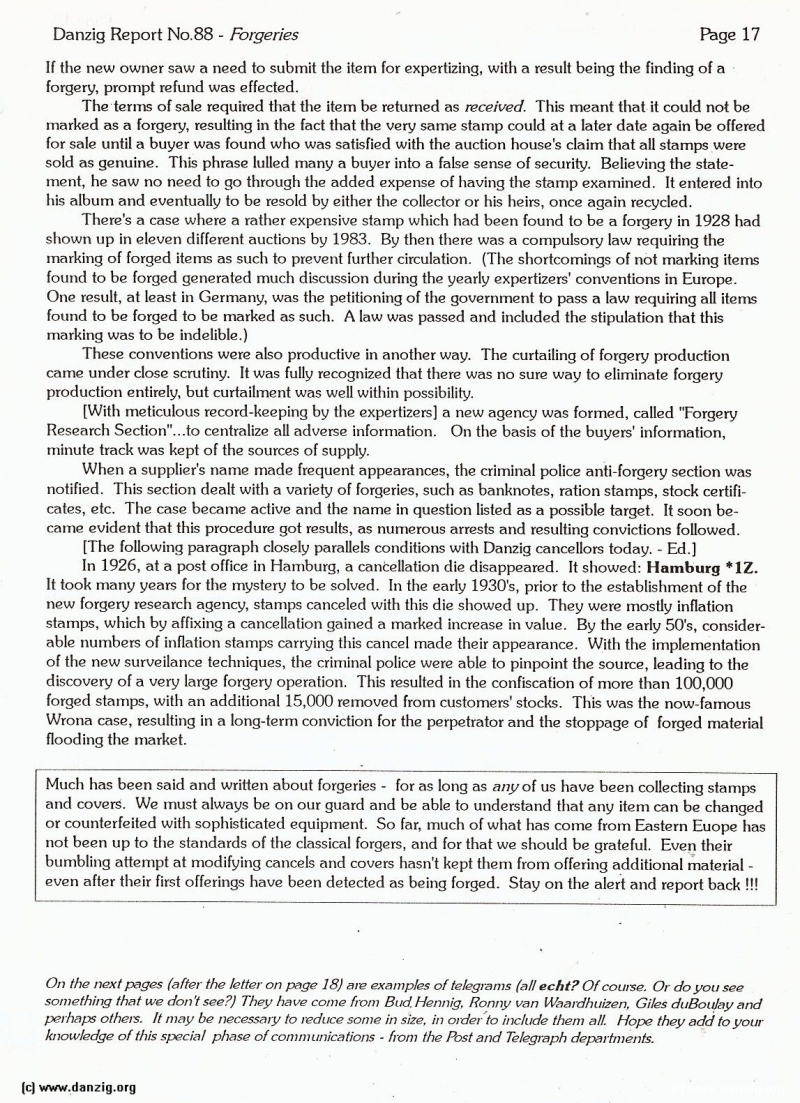
If the new owner saw a need to submit the item for expertizing, with a result being the finding of a forgery, prompt refund was effected.
The terms of sale required that the item be returned as received. This meant that it could not be marked as a forgery, resulting in the fact that the very same stamp could at a later date again be offered for sale until a buyer was found who was satisfied with the auction houses claim that all stamps were sold as genuine. This phrase lulled many a buyer into a false sense of security. Believing the statei rient, he saw no need to go through the added expense of having the stamp examined. It entered into his album and eventually to be resold by either the collector or his heirs, once again recycled.
There’s a case where a rather expensive stamp which had been found to be a forgery in 1928 had shown up in eleven different auctions by 1983. By then there was a compulsory law requiring the marking of forged itelTus as such to prevent further circulation. (The shortcomings of not marking items found to be forged generated much discussion during the yearly expertizers’ conventions in Europe. One result, at least in Germany, was the petitioning of the government to pass a law requiring all items found to be forged to be marked as such. A Law was passed and included the stipulation that this marking was to be indelible.)
These conventions were also productive in another way. The curtailing of forgery production came under close scrutiny. It was fully recognized that there was no sure way to eliminate forgery production entirely, but curtailment was well within possibility.
[With meticulous record-keeping by the expertizers] a new agency was formed, called “Forgery Research Section”. . . to centralize all adverse information. On the basis of the buyers’ information, minute track was kept of the sources of supply.
When a supplier’s name made frequent appearances, the criminal police anti-forgery section was notified. This section dealt with a variety of forgeries, such as banknotes, ration stamps, stock certificates, etc. The case becairie active and the name in question listed as a possible target. It soon bec ame evident that this procedure got results, as numerous arrests and resulting convictions followed.
[The following paragraph closely parallels conditions with Danzig cancellors today. - Ed.]
In 1926, at a post office in Hamburg, a cancellation die disappeared. It showed: Hamburg .IZ. It took many years for the mystery to be solved. In the early 1930’s, prior to the establishment of the new forgery research agency, stamps canceled with this die showed up. They were mostly inflation stamps, which by affixing a cancellation gained a marked increase in value. By the early 50’s, considera ble numbers of inflation stamps carrying this cancel made their appearance. With the implementation of the new surveilance techniques, the criminaL police were able to pinpoint the source, leading to the discovery of a very large forgery operation. This resulted in the confiscation of more than 100,000 forged stamps, with an additional 15,000 removed from customers’ stocks. This was the now-famous Wrona case, resulting in a long-term conviction for the perpetrator and the stoppage of forged material flooding the market.
Much has been said and written about forgeries - for as long as any of us have been collecting stamps and covers. We must always be on our guard and be able to understand that any item can be changed or counterfeited with sophisticated equipment. So far, much of what has come from Eastern Euope has not been up to the standards of the classical forgers, and for that we should be grateful. Even their bumbling attempt at modifying cancels and covers hasn’t kept them from offering additional material - even after their first offerings have been detected as being forged. Stay on the alert and report back !!!
On the next pages (after the letter on page 18) are examples of telegrams (all echt? Of course. Or do you see something that we don’t see?) They have come from Bud Hennig. Ronny van Waardhuizen, Giles du Boulay and perhaps others. It may be necessaiy to reduce some in size, in order to include them alI Hope they add to your knowledge of this special phase of communications - from the Post and Telegraph departments.
Danzig Report Nr. 88 - July - August - September - 1995, Page 17.
Hits: 3376
Added: 11/07/2015
Copyright: 2025 Danzig.org

